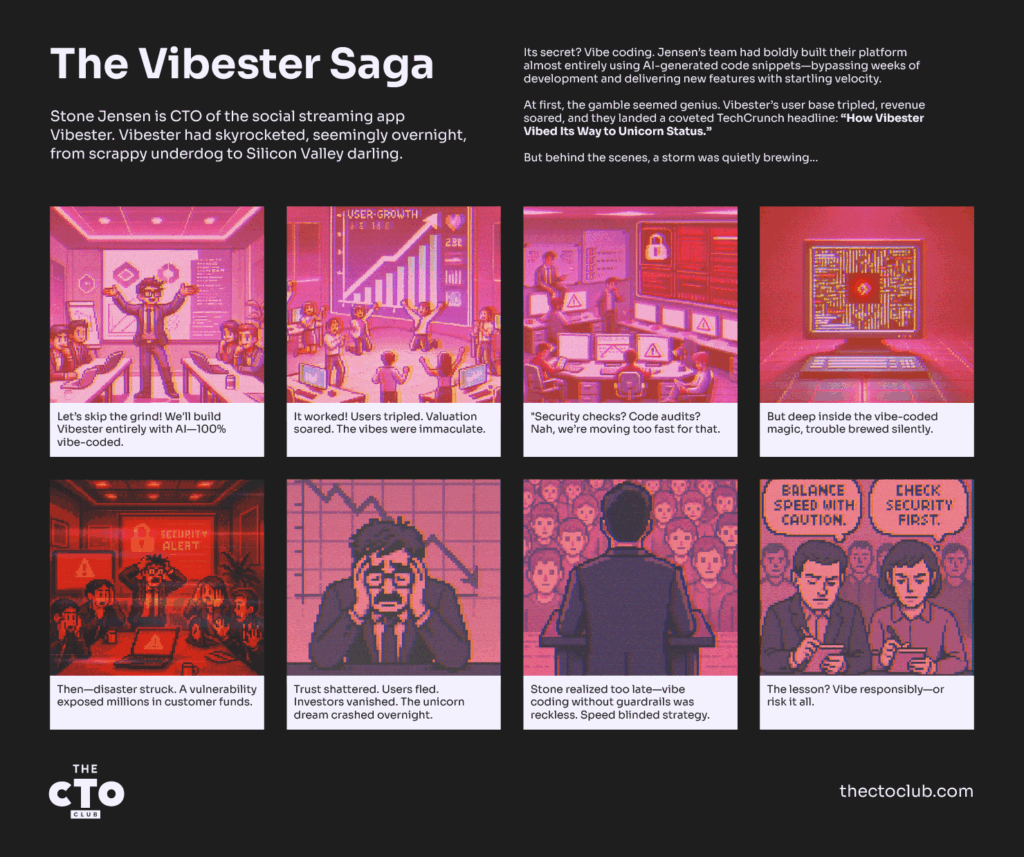If you’ve spent any time lurking on tech LinkedIn lately, you’ve probably bumped into the increasingly noisy concept of "vibe coding." For the uninitiated, "vibe coding" is when developers (and non-developers, let’s be honest) use AI prompts and intuitive "vibes" to whip up code rather than traditional painstaking line-by-line methods.
It sounds like either tech’s latest miracle or the cringiest fad since NFTs hit LinkedIn bios.
The Case For Vibing Hard
The rapid success of vibe-coded projects, like the non-developer who built and shipped a 100K-line AI-generated app profitably within weeks, or Workcade, a gamified productivity to-do app with hundreds of users in the first week, suggests there might be substance behind the buzz.
But where there are vibes, there is also... chaos.
Bad Vibes Only
Vibe coding appears to have a security problem. Consider non-technical entrepreneur Leo Jr., who rode the vibe-coding wave, openly building and launching his app—and quickly turned a profit.
He is the founder of Enrichlead—a tool that collects IP addresses and uses an LLM to generate sales leads. Leo built the entire app using Cursor, proudly declaring: “Zero hand-written code. AI is no longer just an assistant—it’s the builder. You can whine about it, or you can start building.”
Naturally, the internet chose violence.
Within 48 hours, hackers swarmed. Subscriptions were bypassed. Costs skyrocketed. The LLM started hallucinating lead data out of thin air. Leo posted an SOS to Twitter: “guys, i’m under attack … random things are happening.” And then the kicker: “I’m not technical so this is taking me longer than usual to figure out.”
To use Enrichlead, users install a JavaScript snippet that collects IP addresses. The LLM tries to turn that into sales leads. It rarely has enough to work with, so it just makes stuff up. Leo, ever optimistic, insists: “It works tho.”
He now says he’s learning to code. “The hard way,” of course.
So here's the question for modern CTOs: Is vibe coding an innovative shortcut—or are we all just manifesting bugs with a better UX?
Let’s break down when to embrace the vibes and when to avoid them.
What’s the Hot Goss?
DevOps OG David Beale isn’t shy about his enthusiasm for this trend. As he argues, we've been "vibe coding" for years:
"Copy/pasting from Stack Overflow, GitHub Gists, Reddit threads, Slack convos, Hacker News comments—whatever it takes. Great engineers don’t memorize—they solve. They search, pattern-match, adapt, and build. The prompt is just the next evolution of what’s always been there."
His stance isn't without merit. AI-powered vibe coding could indeed become an essential accelerant in the CTO's toolkit. AI-generated code might reduce the monotonous grind, freeing developers for strategic, high-value activities.
Steven Donaghy, Engineering Manager at Microsoft, goes further:
"AI is like alcohol. It amplifies what you already are. If you’re a great coder, it makes you better. If you’re terrible, the output is even worse."
For Donaghy, vibe coding shines in two critical places—the start and the end of projects. Early on, AI helps cut through analysis paralysis. At the end, it excels in leveraging refined examples to accelerate new work.
In short, at its best, vibe coding lets skilled teams rapidly prototype, innovate, and deliver value faster. From this perspective, AI is simply turbocharging an established practice.
But Wait, The Vibes Might Be Off
Before you gather the crystals and start manifesting features into existence, hold on.
As Slalom Director Adam D’Angelo thoughtfully points out, vibe coding isn't without significant drawbacks. He highlights real, pragmatic risks CTOs must consider:
"Security vulnerabilities are a primary concern. LLMs may inadvertently generate code susceptible to injection attacks, cross-site scripting (XSS), and authentication flaws."
D’Angelo underscores additional headaches, including "maintainability" problems due to inconsistent coding standards, "technical debt accumulation," and complex "auditing challenges," especially in highly regulated industries like healthcare or finance.
He also warns about potentially serious legal and compliance implications:
"LLMs may generate code incorporating open source libraries with incompatible licenses... organizations must ensure compliance with industry-specific regulations."
Additionally, overreliance could stunt your team's capability to understand and troubleshoot issues independently, leading to what D’Angelo aptly calls "learned helplessness."
Ouch. Suddenly, vibe coding isn't so whimsical.

Are We Ignoring the 'Vibe Debt'?
For all its intuitive charm, vibe coding carries real risks. Chief among them are technical debt and hidden complexity that emerge once the initial "good vibes" fade. The middle stages of software projects require meticulous architecture and rigorous scrutiny—areas where vibe coding often falls short.
I was really chuckling when Josh Wymer cleverly highlighted these blind spots in a viral LinkedIn post mocking an overly "vibey" job description seeking developers with advanced degrees in "Retroactive Problem Prevention" and expertise in "energy alignment."
Wymer’s satire pokes fun at the reality that innovation isn’t just good intentions—it requires execution, accountability, and discipline. If you trust your entire product strategy to vibes alone, you're setting yourself up for some painful debugging sessions.
So, What's a Vibe-Curious CTO to Do?
For CTOs navigating AI, infrastructure evolution, and increasing executive pressure, the "vibe coding" debate boils down to one question: Can intuitive coding coexist with disciplined engineering?
Yes… If you strategically define where it fits into your organization. Consider this practical checklist:
- Early Innovation and Prototyping: Vibe away. AI tools significantly accelerate early-stage creativity.
- Mission-Critical Applications: Tighten up. Rely on rigorous review and structured code practices.
- Scaling and Security: Non-negotiable rigor. Vibes won’t fix security vulnerabilities or scalability nightmares.
Practical Takeaways (That Aren't Just Good Vibes)
"Vibe coding" isn’t a silver bullet or a disaster waiting to happen. It's another tool in a CTO's arsenal. Smart tech leaders strategically blend intuitive AI-powered coding with robust engineering discipline, clearly outlining when and where vibe coding is acceptable.
As Beale advises, “Don’t knock vibe coding—master it.”
- Embrace strategically, not blindly. Vibe coding isn’t an excuse to abandon good practices. Like Donaghy says, vibe coding amplifies existing skills.
- Institute clear guardrails. Adopt D’Angelo’s guidance to establish rigorous security reviews, auditing frameworks, and code quality protocols around AI-generated outputs.
- Use vibe coding to enhance—not replace—engineering capability. Prioritize team education to maintain technical proficiency and avoid the trap of AI dependence.
Vibe Responsibly
Ultimately, vibe coding isn’t an apocalypse, nor is it a panacea. As a savvy CTO, your best bet is to vibe responsibly: leverage innovation without losing strategic control.
A CTO’s primary responsibility is turning good vibes into great software. So go ahead and vibe-code your way through that next innovation sprint, but don’t vibe too close to the sun.
Subscribe to The CTO Club's newsletter for more hot takes!



